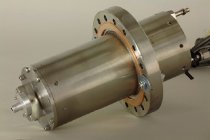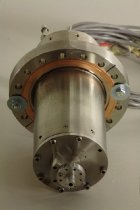Object Record
Images


Metadata
Title |
Beam Source for the AP2 Supersonic Laser Vaporization Cluster Beam Apparatus |
Object Name |
Beam Source |
Object ID |
2004.026.006 |
Description |
Cylindrical component featuring one large silver cylinder with a thick silver/copper disk around the center; three grey rubber coated cables extend out from bottom of large cylinder - one ends as a plug, one as a cable attachment, and the other is spliced; disk has a copper ring toward center and uniform holes around circumference; large cylinder has holes at bottom and screws at top, attachment on top of cylinder has a raised spout |
Dimensions |
H-9.75 Dia-6 inches |
Material |
Nickel, Silver, Copper, Rubber |
Collection |
Richard Smalley Collection |
Search Terms |
AP2 Supersonic Laser Vaporization Cluster Beam Apparatus Buckminsterfullerene Carbon Magnetic Resonance Smalley, Richard E. Kroto, Harold Curl, Robert Source |
Provenance |
Discovered in 1985 by the Rice University research team headed by Richard Smalley, Robert Curl Jr., and Sir Harold Kroto, Carbon 60, also known as buckminsterfullerene or a buckyball, is an allotrope of carbon that has a molecular shape similar to a soccer ball or the geodesic domes of futurist architect Richard Buckminster Fuller. Extremely stable and capable of conducting electricity, buckyballs [] opened up a new area of study in fullerenes, which are being explored for their potential in nanotechnology, electronics, optics, and other material science fields. In the discovery of buckyballs, pulsed laser beams directed at a sample of carbon in the main chamber of the AP2 instrument created a plume of vaporized carbon hotter than the temperature at which some stars are formed. A stream of helium brought about sudden and extreme cooling and the clustering of carbon atoms. A skimmer at the threshold of an adjacent vacuum chamber collected the clusters for analysis by a mass spectrometer. Drs. Smalley, Curl, and Kroto shared the 1996 Nobel Prize in Chemistry for "their discovery of fullerenes." |
